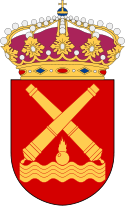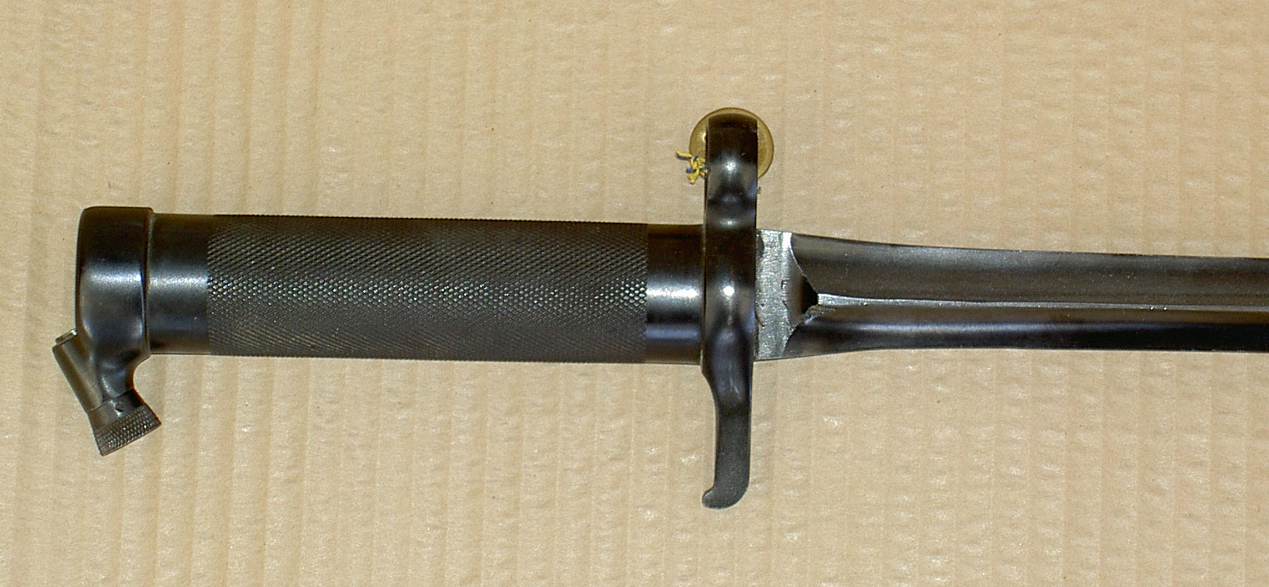Bayonets used by the Coastal Artilley

The Coastal Artillery history and organization
Prior to 1894 personnel from the Navy manned the fortifications at Karlskrona while the other maritime fortresses was manned by personnel from the Army. The mine blockades were however manned by Navy personnel.
Royal Vaxholms Artillery Corps ("Kungl VaxhoIms artillerikår") was established in January 1st 1889. It consisted of one company from the Svea Artillery Regiment and one Fortress Company from the Göta Artillery Regiment. The corps was located at Oskar-Fredriksborg and Rindö, and belonged to the army.
In October 10th 1893 the Royal Karlskrona Artillery Corps ("Kungl Karlskrona artillerikår") was established and manned the Karlskrona fortresses. The Corps consisted of 2 companies from the Navy.
In 1896 they were extended to 4 companies; two on Kungsholm fortress, one on Västra Hästholmen and one on Oscarsvärn. The corps belonged to the Navy.
From the start of 1902 Vaxholm and Karlskrona artillery corps and some mine planter personnel were merged and formed the Royal Coastal Artillery.
The Royal Coastal Artillery consisted of two regiments, the Royal Vaxholm Coastal Artillery regiment ("Kungl. Vaxholms kustartilleriregemente") and the Royal Karlskrona Coastal Artillery regiment ("Kungl. Karlskrona kustartilleriregemente").
| Royal Vaxholm Coastal Artillery regiment | Royal Karlskrona Coastal Artillery regiment | ||
|---|---|---|---|
|
1. AK ex. Kungl. Vaxholms artillerikår 1 comp. |
Kodjupet |
2. AK ex. Kungl. Karlskrona artillerikår 2 comp. |
Ellenabbsfortet |
|
3. AK ex. Kungl. Vaxholms artillerikår 2 comp. |
Värmdöplatån |
4. AK ex. Kungl. Karlskrona artillerikår 4 comp. |
Oskarsvärn |
|
5. AK ex. Kungl. Vaxholms artillerikår 3 comp. |
Oskar Fredriksborg |
6. AK ex. Kungl. Karlskrona artillerikår 1 comp. |
Kungsholmen |
|
7. AK ex. Kungl. Vaxholms artillerikår 4 comp. |
Byvik |
8. AK ex. Kungl. Karlskrona artillerikår 3 comp. |
V Hästholmen |
| 9. AK (newly set up) | Rindö redutt | 10. AK(from 1904) | Kungsholmen |
| 11. AK (from 1905) | Fårösund | 12. AK (from 1906) | Detachement in Göteborg |
| 1. MK (ex. 2. minörkomp.) | 2. MK (ex. 1. minörkomp.) | Aspö mad | |
| 3. MK (newly set up) | 4. MK (from 1904) | Almö | |
| 1. YK (newly set up) | 2. YK (newly set up) | ||
AK = Artillery company, MK = Mine planting company, YK = Craftsmen etc.
The coastal artillery was as most 5 regiments before it was transformed to the Amphibious Corps in 2000
-
KA1, Royal Vaxholms Coastal Artillery regiment, 1902 - 2000
-
KA2, Royal Karlskrona Coastal Artillery regiment, 1902 - 2000
-
KA3, Gotlands Coastal Artillery regiment, 1937 - 2000
-
KA4, Älvsborgs Coastal Artillery regiment, 1942 - 2000
-
KA5, Härnösands Coastal Artillery regiment, 1953 - 1998
Armament
The armament of the three organizations that formed the Royal Coastal Artillery was different.- The two artillery corps were armed with two different rifles, m/67-68 and m/67-89.
- The mine planter company was armed with 6,5 mm carbine m/94 or a revolver and a cutlass
- The Navy stokers and craftsmen were armed with either a cutlass or a revolver.
The re-armament of the newly formed coastal artillery was however very slow, and voices was raised almost immediately to arm them with rifle m/96 instead.
In 1916 a parliamentary decision was issued regarding
"all purchases of firearms for the Coastal Artillery shall from this day be rifle with bayonet instead of carbines"
However, the Coastal Artillery was still after 1925 mainly armed with the 6.5 mm carbine without bayonets. It was not until the late 1930's the re-armament was considered complete, and the main armament was now the rifle m/96 with bayonet.
Bayonets
The following bayonet has been used by the Royal Coastal Artillery.Bayonet m/1864
Royal Vaxholms Artillery Corps (That came from Svea Artillery regiment) war armed with rifle m/1864-68. The bayonets m/1864 were marked e.g. "V.A.K." ("VaxhoIms ArtilleriKår").Bayonet m/67-89
Both originating corps were armed with rifle m/1867-89.For example, bayonet m/1867-89 can be found with the marking "8. A.K." and the navy property mark (trident). It is probably from the Karlskrona Artillery Corps (that belonged to the Navy).
A bayonet marked with "7. A.K." does not have the navy property marking, and comes from Royal Vaxholms Artillery Corps (that belonged to the Army).
Bayonet m/1896
As the Coastal Artillery was re-armed with rifle m/1896, they were also issued with bayonet m/1896.Bayonet m/1914
Some units equipped with the carbine were very probably issued a bayonet as the carbines were modified for bayonet m/1914.Bayonet m/1965
Bayonet m/1965 was issued with the AK4, and it was probably still used with AK5 for parade.Cutlass m/1903
Cutlass m/1903 is not a bayonet, but has a place here as it is a modified sword bayonet m/1867.It was approved as "huggare m/03" in 1903, general order 167 for stokers and craftsmen belonging to the Royal Coastal Artillery.
Markings
This table is not complete, but give a good view of how the coastal artillery bayonets were marked.| Marking | Meaning | Example | Weapon |
|---|---|---|---|
| V.A.K. | Vaxholms artillerikår Ca 1889 - 1902 | V.A.K. B. No 1234 |
bayonet m/1864. Typically on the socket and the scabbard frog hook. |
| V.K.A.R. | Vaxholms Kustartilleriregemente | V.K.A.R. 120 | Cutlass m/1903. On the guard and mouthpiece. |
| C.K.A.R. | Carlscrona Kustartilleriregemente | C.K.A.R. 240 | Cutlass m/1903. On the guard and mouthpiece. |
| 8. A.K. | 8 Artillerikomp (CKAR) | 8. A.K. 44. | bayonet m/67-89 The bayonet is marked with the navy trident |
| 7. A.K. | 7 Artillerikomp (VKAR) | 7. A.K. No 74 |
bayonet m/67-89 The bayonet is NOT marked with the navy trident |
| SK | Stockholms Kustartilleriförsvar Ca 1942 - 1975 | SK | bayonet m/1896 |
| BK | Blekinges Kustartilleriförsvar Ca 1942 - 1975 | BK. No 1035 | bayonet m/1896 | GK | Gotlands Kustartilleriförsvar Ca 1938 - 1976 | GbK | Göteborgs Kustartilleriförsvar Ca 1939 - 1985 | Gb K No 2088 | bayonet m/1896 | HK | Hemsö Kustartilleriförsvar Ca 1945 - 1975 | NK | Norrlandskustens Kustartilleriförsvar Ca 1975 - 1994 | KA1 | Kungl. Vaxholms kustartilleriregemente | KA.1.1084 K.A.1 |
bayonet m/1896 bayonet m/1914 |
KA2 | Kungl. Karlskrona kustartilleriregemente | KA.2 No 1482 | bayonet m/1896 | KA3 | Gotlands kustartilleriregemente | bayonet m/1896 | KA4 | Älvsborgs kustartilleriregemente | bayonet m/1896 | KA5 | Härnösands kustartilleriregemente | bayonet m/1896 |
Bayonet trials
In 1905 the Navy raised the question about a carbine bayonet.The Coastal Artillery was also interested in a bayonet, but as they were armed with both rifles and carbines they could either equip the carbine with a bayonet, or replace the carbine with rifle m/96 and the already existing bayonet.
The Coastal Artillery Chief in Command wrote in 1909 "The need of a powerful thrust weapon is now so obvious, that the reasons to choose the carbine by the 1900 Coastal Artillery committee is no longer valid, and the carbine should be replaced by the rifle m/96" .
During the years of 1909 to 1912 trials were performed at both the Navy and the Coastal Artillery with knife and sword bayonets for the carbine.
See a separate article about the carbine bayonet trials.

Trial bayonet with medium long blade

Trial bayonet with long blade
As the troop trials with the new bayonets were declared failed, the wish to replace the carbine with 6,5 mm rifle m/96 was further reinforced.
Both the Coastal Artillery and the Navy advocated the longer bayonet, and it is maybe therefore the possibility to mount a longer bayonet on the rifle m/96 was looked at. In general the existing rifle bayonet m/1895 was considered too short, and some years later several trials with a longer bayonet was performed.
In 11th November 1912 a proposal of a cruciform blade bayonet "stickbajonett" (drawing and model) was delivered to the Royal Marine Office.
Rifle m/96 could without any modifications be equipped with this bayonet and the cost to replace one carbine with one new 6,5 mm rifle m/96 with bayonet would be 6,50 kr.
Below is a transcription of the document issued to the Royal Marine administration. I have not translated it, but in the document there is a note about the blade being quite thin close to the guard, where it is mounted in the handle. The reason for that being the manual manufacturing process.
|
Angående eventuellt utbyte av Kustartilleriets karbiner mot gevär försedda med stickbajonett
Från Kungliga Armeförvaltningens Artilleridepartementet, diarienummer 533 MI Till Kungliga Marinförvaltningen (Inkom till marinförvaltningen den 11 september 1912 diarienummer 97G) Med anledning av er skrivelse den 23 sistlidne juli diarienummer 97B alt 790 för Kungliga armeförvaltningens artilleridepartementet med anledning av eventuellt utbyte av KA's 6,5 mm karbiner m/94 mot 6,5 mm gevär m/96 får jag härmed meddela: Dels att de för utbyte avsedda gevären kunna utan ändring å själva gevären förses med stickbajonett enligt bifogad ritning och modell varvid med avseende på modellen dock är att bemärka att på densamma synliga godsknappheten i närheten av tången har sin orsak i bajonettens omsmidning för hand utan erfordeliga verktyg och kommer en dylik godsförknappning ej att förefinnas vid en tillverkning i större skala. Dels att den mellanavgift som skall erläggas av eder för utbyte av en obegagnad 6,5 mm karbin m/94 med rem och söljstycke mot ett obegagnat 6,5 mm gevär m/96 med stickbajonett enligt ovan översända modell, bajonettbalja av läder, gevärsrem och knapp utgör kronor 6.50. I övrigt får departementet hänvisa till sina skrivelser i ärendet den 1 och 25e sistlidna april, diarienummer 533 MI Stockholm 9 september 1912 F R Leth |
The bayonet is only known in one example, and it is my guess that only a very few project models were made. They were (in this form) never tried or issued.
The modification consists of the blade of a m/1867 (or m/1867-89) bayonet that is milled to fit the m/1896 hollow handle. The original m/1867 scabbard is kept.
It seems like this project never led to any trials or orders.

Project model, cruciform blade bayonet for rifle m/96 for the Coastal Artillery.

Project model, cruciform blade bayonet for rifle m/96 for the Coastal Artillery.

Close-up of the blade mounting.
There is another bayonet based on the m/1896 handle with a cruciform blade. The blade is shorter, and the mounting of the handle is different. A serial number is struck on the guard.
I do not know if this is a continuation of the project, tested by the coastal artillery, or a completely different variation.

Close-up of the marking.
Since the exchange of the carbines took a very long time, new trials with a cruciform and sword bayonets for the carbine was arranged in 1928 ! The trials were unsuccessful, and I have unfortunately not found any information about these trials.
4. References
| References | |
|---|---|
| [1] | Schöön, Björn. "Bayonets, Bajonetter, Bajonette", 1986 |
| [2] | Ankomna handlingar 1912 Kungliga Marinförvaltningen |
| [3] | Allan Cyrus: Kungl Kustartilleriet 1902 - 1952 |
| [4] | tjelvar.se |